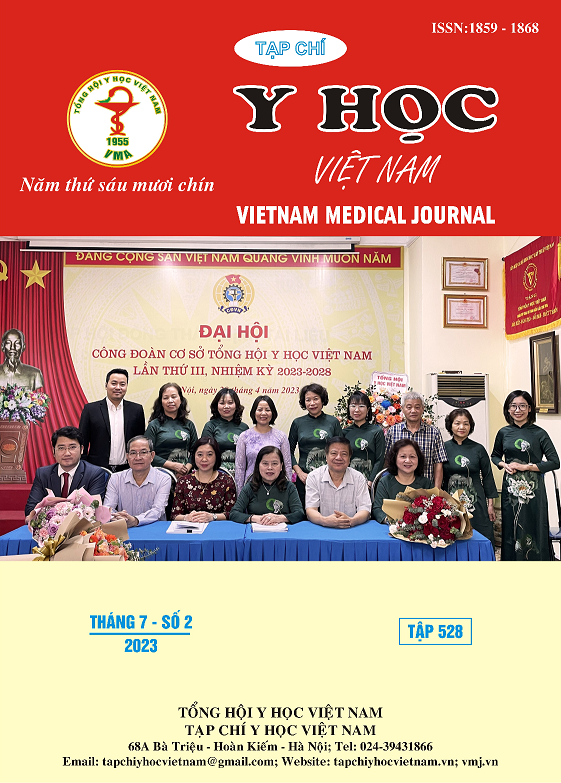RELATION BETWEEN CHRONIC DISEASES AND TRADITIONAL MEDICINE CONSTITUTIONS OF PEOPLE IN WARD 5, DISTRICT 10, HO CHI MINH CITY
Main Article Content
Abstract
Objective: To describe the traditional medicine constitutions (TCMC) and its relationship with chronic diseases of people in Ward 5, District 10, Ho Chi Minh City. Subjects and methods: A cross-sectional descriptive study from April 2022 to the end of October 2022 on 449 people aged 15 years and older living in Ward 5, District 10. Results: Female accounted for 37% less than male. The age was mainly in the group 45 – 64 years old (41%), mostly people are in the normal range of BMI (49%). Dyslipidemia was the highest rate (32%), followed by hypertension (31%), type 2 diabetes (10%), coronary heart disease (8%), chronic obstructive pulmonary disease (COPD) (6%), cancer (2%) and stroke (3%). Inherited special constitution was the most frequent TCMC type (20%), Yin-deficiency and Blood-stasis were both 19%, Qi-depressed 18%, Qi-deficiency 15%, Yang-deficiency 12%, Phlegm-wetness 8%, Wetness-heat 6%, normality constitution was 5%. Qi-deficiency constitution was associated with type 2 diabetes (OR=2.83) and hypertension (OR=2.13), Yang-deficiency was associated with hypertension (OR=2.03), Qi-depressed and Phlegm-wetness were related to dyslipidemia (OR=3.07 and OR=0.42), Blood-stasis was related to COPD (OR=2.83). Conclusion: The majority of study participants are male, mainly from 45 to 64 years old, average BMI, chronic diseases are usually hypertension, dyslipidemia, diabetes.. Traditional Chinese Medicine Constitution are mainly Inherited special, Yin-deficiency, Blood-stasis, Qi-depressed, Qi-deficiency, Yang-deficiency, Phlegm-wetness. Qi-deficiency constitution was associated with type 2 diabetes and hypertension, Yang-deficiency was associated with hypertension, Qi-depressed and Phlegm-wetness were related to dyslipidemia, Blood-stasis was related to COPD
Article Details
Keywords
Traditional Chinese Medicine Constitution, chronic diseases.
References
2. Trịnh Thị Diệu Thường và các cộng sự (2021), "Khảo sát các thể lâm sàng Y học cổ truyền trên bệnh nhân đái tháo đường type II", Tạp chí Y Học TP. Hồ Chí Minh. Tập 25(Số 5), tr. 20 -26.
3. Yanying Kong và các cộng sự (2015), "Investigation of Traditional Chinese Medical Constitution Types and Cardiovascular Risk Factors in Hypertension Patients:An Analysis of 1108 Cases", Journal of Guangzhou University of Traditional Chinese Medicine. 6, tr. 598-602.
4. Wang Qi và các cộng sự (2009), "Epidemiological investigation of constitutional types of Chinese medicine in general population: based on 21,948 epidemiological investigation data of nine provinces in China.", China Journal of Traditional Chinese Medicine and Pharmacy. 24(1), tr. 7-12.
5. Y. Wang và các cộng sự (2021), "Body Constitution and Unhealthy Lifestyles in a Primary Care Population at High Cardiovascular Risk: New Insights for Health Management", Int J Gen Med. 14, tr. 6991-7001.
6. Lin Xiaomei và các cộng sự (2018), "Study on the Correlation betw een Traditional Chinese Medicine Constitution and Obesity, Blood Coagulation, Blood Lipids and Smoking Index in Patients w ith COPD", Chinese Medicine Modern Distance Education Of China. 16 (24), tr. 48-50.
7. WJ Zhang và các cộng sự (2017), "Analysis of distribution of TCM constitutions and complications such as hyperuricemia of 534 patients with hyperlipemia", Chin Arch Tradit Chin Med. 35(4), tr. 984-988.
8. Yanbo Zhu và các cộng sự (2017), "Association between Nine Types of TCM Constitution and Five Chronic Diseases: A Correspondence Analysis Based on a Sample of 2,660 Participants", Evidence-Based Complementary and Alternative Medicine. 2017, tr. 1-7.


